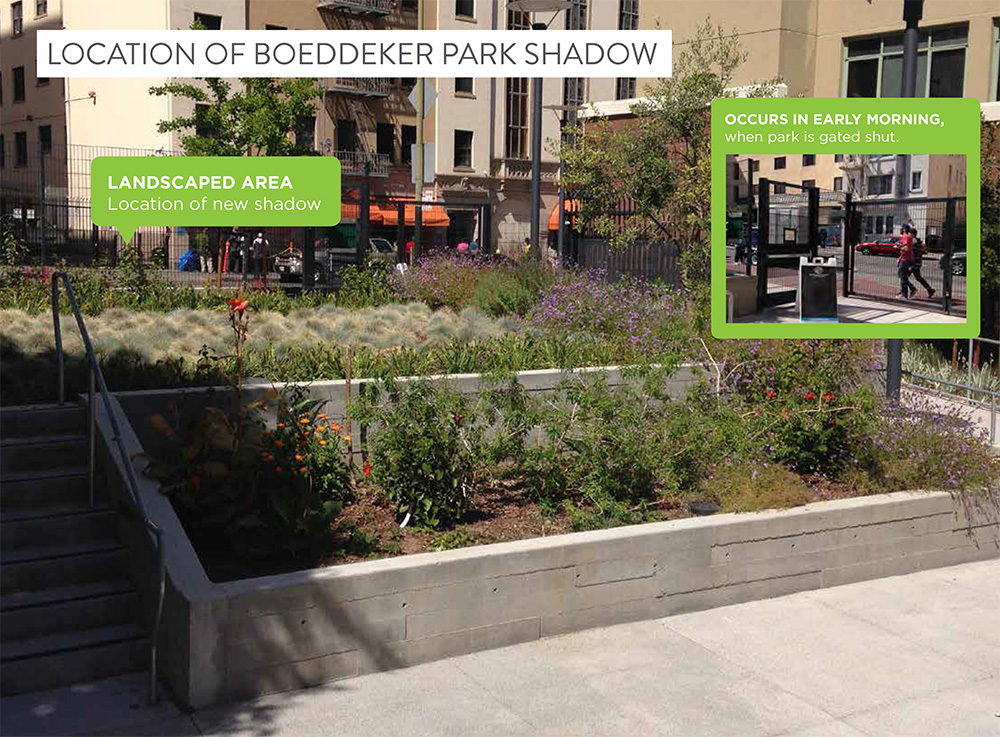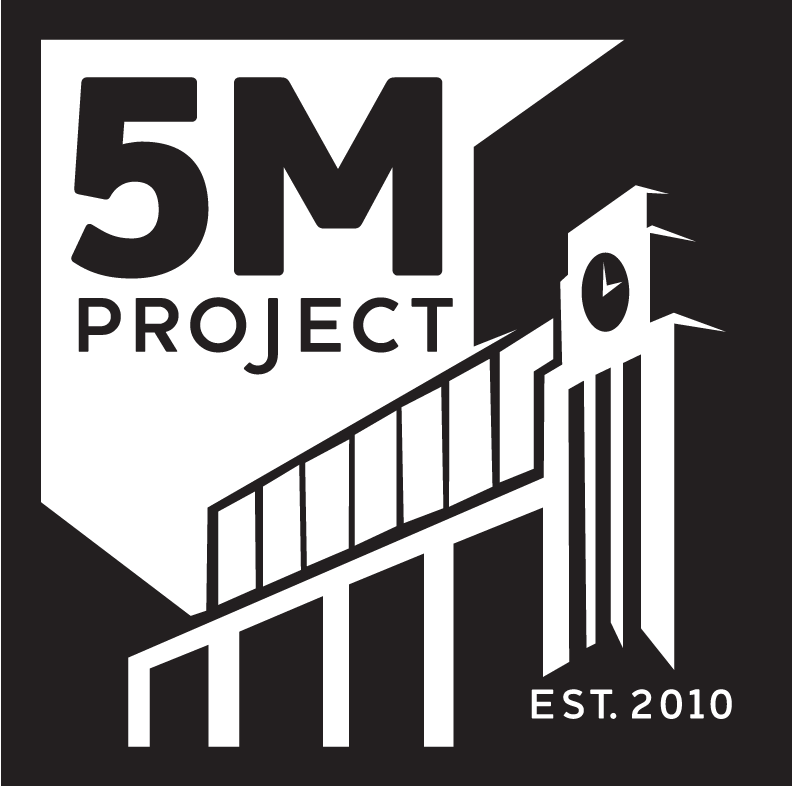The Facts About 5M
Question: Will the taller buildings produce shadows on neighborhood parks?
5M Project Fact: 5M produces a minimal shadow on the Tenderloin’s Boeddeker Park, the only affected open space that is regulated by Section 295 of the Planning Code.
- Percentage increase: 5M would increase shadow on Boeddeker Park by 0.00418%.
- Time and location: Net new shadow would fall on an inaccessible landscaped terrace located at the northern edge of the park, in or around winter months (Oct 18–Nov 29 and Jan 11–Feb 22), in morning hours during which the park’s gates are closed (always before 8:40 am).

Boeddeker Park shadow
Historically, parks regulated by Section 295 have had their shadow limits amended minimally through joint resolution of the Planning Commission and Recreation and Park Commission, based on the qualitative merits of proposed projects and the particulars of shadow effects.
Question: How much affordable housing will 5M offer?
5M Project Fact: 5M will provide 241 affordable units – equal to 40% of market-rate units. Over 2/3 of these units will be provided on sites under the developer’s control.
- 87 as part of the on-site affordable housing at the M2 residential building, 83 senior units at 967 Mission Street less than 300 feet away from the 5M site and is also owned by the project sponsor and 71 additional homes at the Eddy & Taylor development, within a five minute walk from the 5M site.
- Most affordable units will be available to people making up to a maximum 50% of the area median income (AMI). For example, one person living alone could make a maximum of $35,700 to qualify, while a household of four could make a maximum of $50,950.
- The M2 building will feature 87 units that will be permanently affordable, dedicated to middle-income households making a maximum of 100% to 150% of AMI..
- 5M will be the first project of its kind to make this commitment.
Question: How will 5M deal with pedestrian safety and traffic?
5M Project Fact: Pedestrian Safety
5M incorporates multiple strategies to improve pedestrian safety:
- Sidewalk widening from 10 feet today to 18 feet on the west side of 5th Street between Mission and Howard and loading dockets equaling one-third of total street frontage.
- Sidewalk widening from 10 feet today to 20-25 feet on the east side of 5th Street between Mission and Minna – including the removal of a dedicated right-turn lane and the traffic island “pork chop,” a significant pedestrian hazard.
- Curb cuts (driveway entrances and exits) will be reduced from about 200 feet today down to about 120 feet under 5M.
- Sightline “triangle” cutouts are required at driveway exits so vehicles have improved visibility of pedestrians.
- To implement the Better Streets Plan, which is a city-wide plan, 5M will be widening the sidewalk by reducing a portion of a loading lane.
- Access to off-street loading bays is internalized, to avoid queuing of trucks onto major streets Mission, 5th, and Howard.
5M Project Fact: Traffic
Public transit (including BART, Muni Metro, and the future Central Subway) and retail services are abundant in the area. Employees and residents would be able to walk or utilize transit to commute and satisfy convenience needs without reliance on the private automobile.
Furthermore, 5M will install 495 bicycle parking stalls, four showers and 24 lockers on site to encourage trips to the site by bicycle.
Car trips
- Cars represent about a quarter of all trips to and from 5M.
- There will be an approximate daily total of 4,025 vehicle trips a day to and from 5M. 5M’s Transportation Demand Management (TDM) program reduces vehicle trips by about 13% -- to a total of approximately 3,500 daily vehicle trips.
- Evening peak hour is anticipated to have 465 car trips – approximately 405 trips under the 5M TDM plan.
- In anticipation of future changes to Market Street, the cumulative transportation model as incorporated in the 5M Final Environmental Impact Report assumes a general reduction in car capacity along Market Street. More specific plans, such as a Better Market Street and Safer Market Street, are anticipated to generally improve conditions for pedestrian, bicyclists, and transit along Market Street, and are not expected to substantially change the conclusions of the transportation analysis for 5M.
Question: How will 5M reduce hazardous wind conditions?
5M Project Fact: 5M will actually reduce existing hazardous wind conditions and improve wind comfort conditions in front of the Mint Mall building. As it stands now, there are a total of 79 hours of hazardous winds a year near the 5M site. 5M’s buildings are located and shaped to reduce the hazardous wind occurrence to 4 hours a year, a reduction of 95 percent. This should have a positive impact on pedestrians in the neighborhood.
Question: Will 5M displace any residents?
5M Project Fact: There are no residents living at the 5M Project site, so no one will be displaced. But 5M will produce 212 new units of affordable housing for families and seniors.
Question: How much open space does 5M provide for the public?
5M Project Fact: 5M is committed to making the open space accessible and inviting for the neighborhood and the community at large. The open space, historic and older buildings, along with the base of the new buildings is the civic heart of the site. Adding 1.25 acres of downtown open space in District 6, the most open space deficit district of all of San Francisco, only happens through a structure like the Special Use District (SUD). 5M has also committed to working with the community on the design, programming and operations for the open space.
Question: Has 5M worked with the community and surrounding neighborhoods on this project?
5M Project Fact: 5M is the result of a community planning effort with surrounding neighborhoods and City residents.
- 5M has held nearly 200 community meetings and tours since 2009, ninety of which were held after the release of the project’s Initial Study in 2013.
Outreach tools have included: Hosted SOMA neighborhood “mixers”, wide distribution of postcards and flyers, door to door canvassing, meeting local businesses, residents, neighborhood and organization leaders and members, regular attendance at meetings of community presentations to community organizations and interested parties, guided walking tours of project site, community office hours, regular distribution of email information and notices, posting of information and presentations on the project website.
